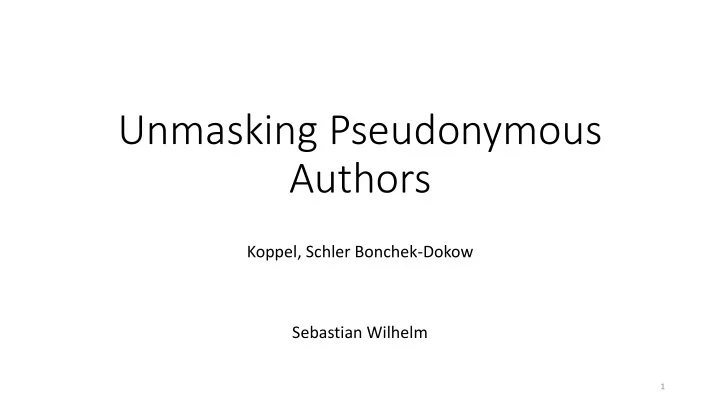

Unmasking Pseudonymous Authors Koppel, Schler Bonchek-Dokow Sebastian Wilhelm 1
• We have : examples ofthe writing of a single author • Task : determine if given texts were or were not written by this author 2
• We do not lack negative examples • Just because text is more similar to A does not mean it was authored by A rather than by B • Chunking the text so we have multiple examples (if text is long) • Given two example sets -> determine if sets were generated in a single generation process 3
• Authorship Verification: Naive Approaches • Lining up impostors: • Model A vs. Not-A • X -> chuked -> A or not-A • Not-A => not author (true) • A => author (not true) 4
• Authorship Verification: Naive Approaches • One class learning: • Circumscribes all positive examples of A • Conclude: X is authored A if a sufficient number of chuks of X lie inside boundry 5
• Authorship Verification: Naive Approaches • Comparing A directly to X: • Learn a model for A vs. X • Assess the extent of difference between A and X using cross-validation • Easy to distinguish => high accuracy in cross-validation => A did not write X 6
• New Approach: Unmasking • Idea : small number of features can distinguish between texts (e.g. he vs. she) • Solution : determining not only if A is distinguishable from X but also how great is the difference between A and X 7
• New Approach: Unmasking • => unmasking: • Iteratively remove those features that are most useful for distinguishing between A and X • Gauge the speed with which cross-validation accuracy degrades as more features are removed • A and X by same author => differences between them will be reflected in only a small number of features 8
• Unmasking Applied: • n words with highest average frequency in Ax and X as initial feature • 1. Determine the accuracy results of a ten-fold cross-validation experiment for Ax against X • 2. Eliminate the k most strongly weighted positive and negative features • 3. Go to step 1 9
=> Degeneration curves for each pair <Ax,X> 10
• Meta-learning: Identifying Same-Author Curves • Quantify the difference between same-author and different-author curves • Each curve as a numerical vector in terms of its essential features: • Accuracy after i elimination rounds • Accuracy difference between round i and i+1 • Accuracy difference between round i and i+2 • Highest accuracy drop in one iteration • Highest accuracy drop in two iterations 11
• Meta-learning: • Sort vectors in two subsets: • Ax, X = same author • Ax, X = different author • For all same-author curves: • Accuracy after 6 elimination rounds is lower than 89% • AND the second highest accuracy drop in two iterations is greater than 16% 12
13
• Extension: Using Negative Examples • Learn model of A vs. Not A • Test each example of X (assigned to A or not-A?) • If many are assigned not A => X is not the author • BUT not true for the opposite conclusion 14
• Extension: Using Negative Examples • For each author A choose impostors A1…An ( as not-A class) • Learn A vs. Not A • Learn models for each Ai vs. Not Ai • Test all examples in X against each other of these models • A(X) = percentage of examples of X classed as A • Ai(X)= percentage of examples of X classed as Ai • A(X) < Ai(X) for all i => A is not by author of X • Otherwise A may be by author of X 15
• Conclued that A is t the author of X if both methods indicate it 16
• Alternative: Measure of Depth of Difference • Check number of features with significant information gain between authors • Not as good as unmasking 17
• Conclusion • High accuracy • Even better with additional negative data • Language, period and genre independent 18
Recommend
More recommend